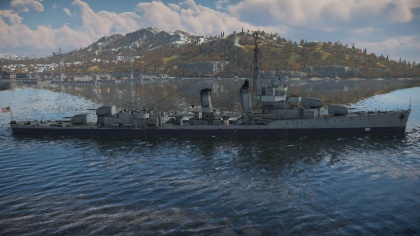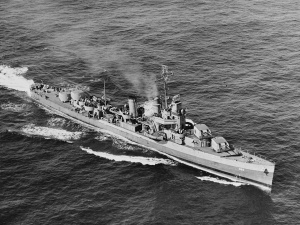USS Moffett
Contents
Description
The Porter-class, USS Moffett (DD-362), 1942 is a premium rank III American destroyer
with a battle rating of 5.0 (AB/RB/SB). It was introduced in Update "New Power".
General info
Survivability and armour
Talk about the vehicle's armour. Note the most well-defended and most vulnerable zones, e.g. the ammo magazine. Evaluate the composition of components and assemblies responsible for movement and manoeuvrability. Evaluate the survivability of the primary and secondary armaments separately. Don't forget to mention the size of the crew, which plays an important role in fleet mechanics. Save tips on preserving survivability for the "Usage in battles" section. If necessary, use a graphical template to show the most well-protected or most vulnerable points in the armour.
Mobility
Write about the ship's mobility. Evaluate its power and manoeuvrability, rudder rerouting speed, stopping speed at full tilt, with its maximum forward and reverse speed.
| Mobility Characteristics | |||
|---|---|---|---|
| Game Mode | Upgrade Status | Maximum Speed (km/h) | |
| Forward | Reverse | ||
| AB | |||
| Upgraded | 84 | 35 | |
| RB/SB | |||
| Upgraded | 69 | 29 | |
Armament
Primary armament
Provide information about the characteristics of the primary armament. Evaluate their efficacy in battle based on their reload speed, ballistics and the capacity of their shells. Add a link to the main article about the weapon: {{main|Weapon name (calibre)}}. Broadly describe the ammunition available for the primary armament, and provide recommendations on how to use it and which ammunition to choose.
Secondary armament
Some ships are fitted with weapons of various calibres. Secondary armaments are defined as weapons chosen with the control Select secondary weapon. Evaluate the secondary armaments and give advice on how to use them. Describe the ammunition available for the secondary armament. Provide recommendations on how to use them and which ammunition to choose. Remember that any anti-air armament, even heavy calibre weapons, belong in the next section. If there is no secondary armament, remove this section.
Anti-aircraft armament
An important part of the ship's armament responsible for air defence. Anti-aircraft armament is defined by the weapon chosen with the control Select anti-aircraft weapons. Talk about the ship's anti-air cannons and machine guns, the number of guns and their positions, their effective range, and about their overall effectiveness – including against surface targets. If there are no anti-aircraft armaments, remove this section.
Torpedo armament
Torpedo launchers are standard equipment on many ships and boats. Torpedoes are a significant means of defeating an opponent. Evaluate the position of the torpedo launchers, discuss the ammunition available, firing specifics such as dead zones, features of the torpedoes themselves, etc. If there is no torpedo armament, remove this section.
Special armament
Depth charges, mines, rocket launchers and missiles are also effective in skilled hands and can take an off-guard opponent by surprise. Evaluate the ammunition of this type of armament and rate its performance in combat. If there are no special armaments, remove this section.
Usage in battles
Describe the technique of using this ship, the characteristics of her use in a team and tips on strategy. Abstain from writing an entire guide – don't try to provide a single point of view, but give the reader food for thought. Talk about the most dangerous opponents for this vehicle and provide recommendations on fighting them. If necessary, note the specifics of playing with this vehicle in various modes (AB, RB, SB).
Modules
| Tier | Seakeeping | Unsinkability | Firepower | |||
|---|---|---|---|---|---|---|
| I | Dry-Docking | Tool Set | 5 inch Common MK.32 | 20 mm HE | Anti-Air Armament Targeting | |
| II | Rudder Replacement | Fire Protection System | Smokescreen | 5 inch Common MK.46 | 20 mm AP | Auxiliary Armament Targeting |
| III | Propeller Replacement | Shrapnel Protection | Ventilation | 5 inch AAVT MK.31 | Improved Rangefinder | Primary Armament Targeting |
| IV | Engine Maintenance | New Pumps | Ammo Wetting | Torpedo Mode | Bomb Mortar | |
| This is a premium vehicle: all modifications are unlocked on purchase | ||||||
Pros and cons
Summarise and briefly evaluate the vehicle in terms of its characteristics and combat effectiveness. Mark its pros and cons in the bulleted list. Try not to use more than 6 points for each of the characteristics. Avoid using categorical definitions such as "bad", "good" and the like - use substitutions with softer forms such as "inadequate" and "effective".
Pros:
Cons:
History
USS Moffett was the third destroyer of the Porter class, an inter-war destroyer design built for the US Navy. Commissioned in late 1936, the Moffett was immediately put to service as a peacekeeper in the South American theatre. She escorted president Franklin D. Roosevelt to his conference with Winston Churchill, and saw active service as a convoy escort in the Atlantic theatre. During her time as a submarine escort, she contributed to the sinkings of two U-Boats. Moffett was decommissioned after the end of the war, and scrapped in 1947.[1][2]
Design and development
The Moffett was a member of the Porter class, a class of eight American destroyers intended to replace the preceding Farragut class. Despite being initially designed in 1916, the ships were not built until the early 1930s. Intended to fit within the 1850-ton displacement limit of the London Naval Treaty, Moffet ended up displacing almost 2700 tons full as the design was improved.[1] She was 116 metres long, and with 50 000 shaft horsepower, could make 37 knots (69 km/h).[1] Her main armament consisted of eight 5-inch (127 mm) single-purpose guns in four double mounts.[1] She also carried a variety of anti-aircraft defenses, and eight torpedo tubes in two quadruple mounts.
Moffett was laid down in 1934 by the Bethlehem Steel Shipyard, and was launched in December of 1935.[1] She was named after William Moffett, an American Rear Admiral who was also known as the “architect of naval aviation” due to his role in the development of American naval aviation and aircraft carriers. After being completed, she was formally commissioned on August 28th, 1936.[1]
Operational History
After her commissioning, the Moffett was immediately put to use in peacekeeping operations. She sailed as part of the Southern Atlantic Neutrality Patrol in 1941, which was responsible for maintaining peace off of the coast of Brazil. During this time, she also escorted president Franklin D. Roosevelt to his conference with British Prime Minister Winston Churchill in Labrador, Canada.[2]
Following the American entry into World War II, Moffett served as a convoy escort in the Atlantic ocean.[2] It was during this time that she achieved her first submarine kill; this occured when the Moffett sighted a U-Boat that had been previously attacked by allied PBM Mariners. She, along with destroyer USS Jouett (DD-396), successfully sank the submarine using gunfire.[2] Just three months later, Moffett was escorting another allied convoy when she encountered another submarine, U-604. Following a chase that lasted an entire week, the Moffett managed to severely damage the submarine using depth charges, which led to it’s scuttling.[2]
Moffett spent the remainder of the war as a convoy escort, defending allied convoys travelling from the Caribbean to Europe. She returned to the US in 1945 to receive a refit, but the war ended while she was still in the drydock. As a result, Moffett was decommissioned, and scrapped in 1947.[1][2] She received two stars for her service during the war.
Media
Excellent additions to the article would be video guides, screenshots from the game, and photos.
See also
Links to articles on the War Thunder Wiki that you think will be useful for the reader, for example:
- reference to the series of the ship;
- links to approximate analogues of other nations and research trees.
External links
Citations
Bibliography
- Willishaw, F. (1996). USS Moffett (DD-362). Retrieved November 29, 2020, from http://www.navsource.org/archives/05/362.htm
- The Tin Can Sailors. (1996). USS Moffett. Retrieved November 29, 2020, from http://www.destroyers.org/histories/h-dd-362.htm
| USA destroyers | |
|---|---|
| Clemson-class | USS Welborn C. Wood · USS Barker · USS Litchfield |
| Farragut-class | USS Aylwin |
| Bagley-class | USS Bagley |
| Porter-class | USS Porter · USS Phelps · USS Moffett |
| Somers-class | USS Somers · USS Davis |
| Fletcher-class | USS Fletcher · USS Bennion · USS Cowell |
| Allen M. Sumner-class | USS Sumner |
| Gearing-class | USS Gearing · USS Frank Knox |
| Mitscher-class | USS Mitscher · USS Wilkinson |
| USA premium ships | |
|---|---|
| Motor torpedo boats | PT-3 · PT-109 · PT-174 · Thunderbolt (PT-556) · PT-658 · PT-811 |
| Motor gun boats | LCM(6) Zippo · USS Douglas · USS Flagstaff |
| Sub-chasers | Carmi (PC-466) |
| Destroyers | USS Welborn C. Wood · USS Wilkinson · USS Bennion · USS Cowell · USS Davis · USS Moffett · USS Phelps · USS Frank Knox |
| Light cruisers | USS Detroit · USS Helena |
| Heavy cruisers | USS Des Moines |
| Battleships | USS Arkansas |






